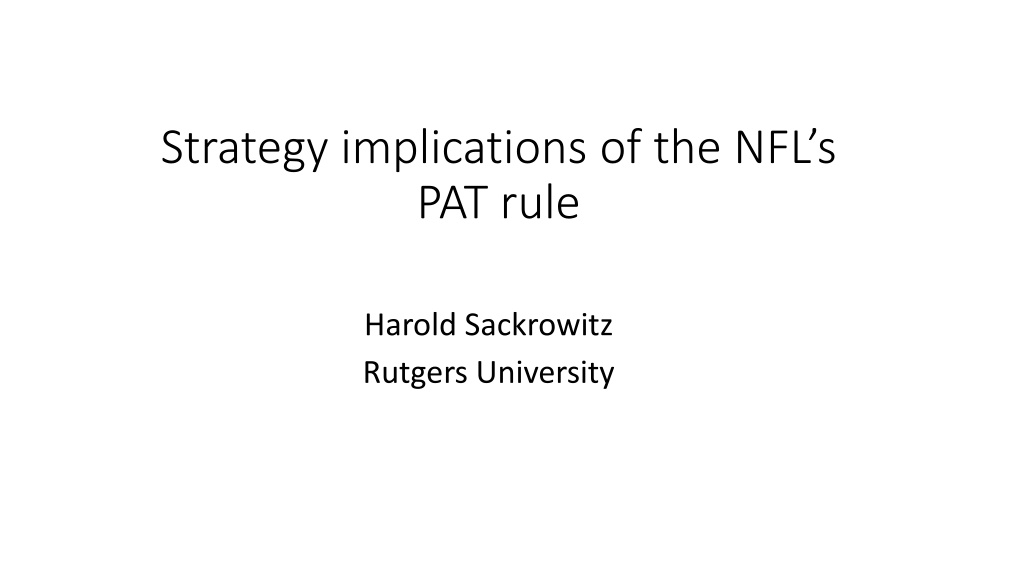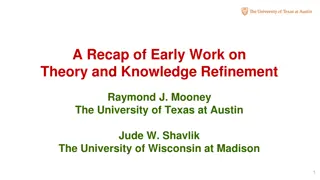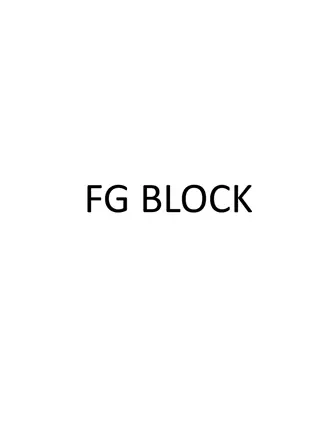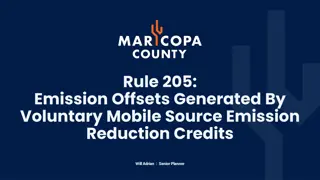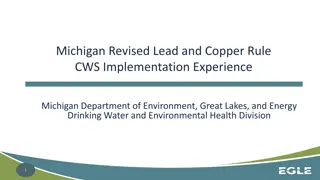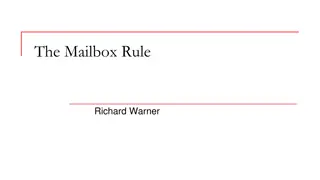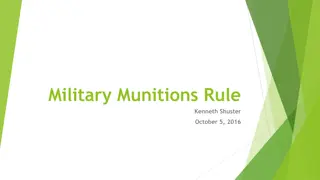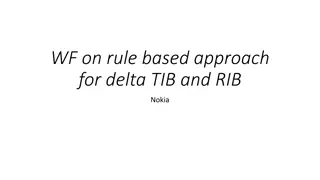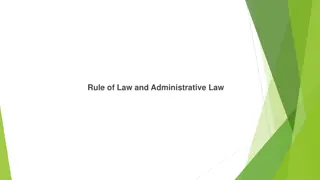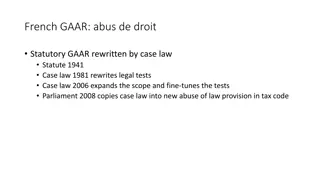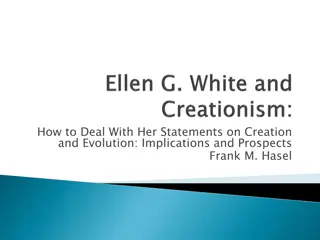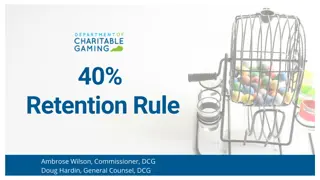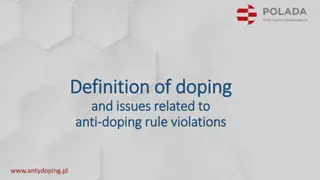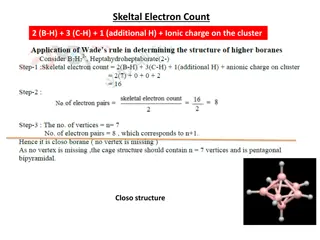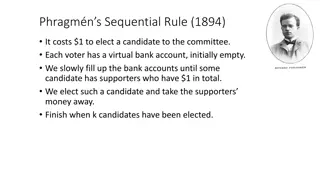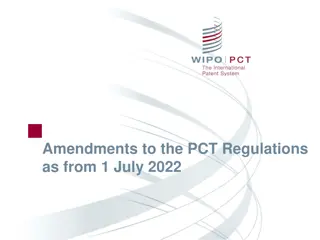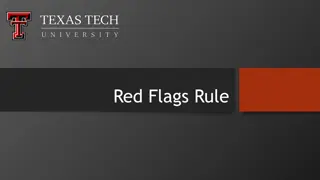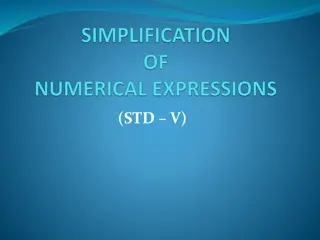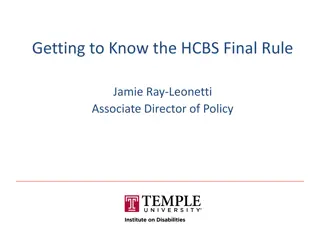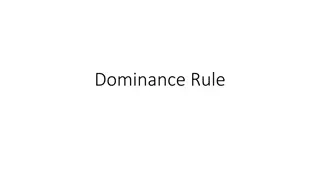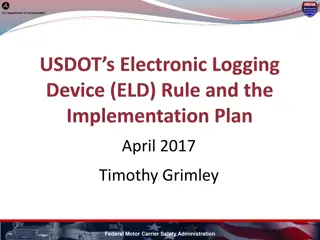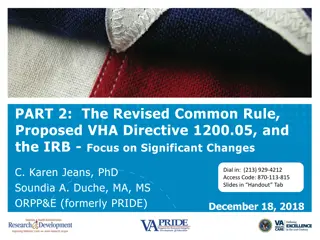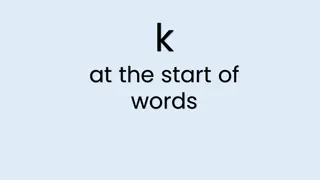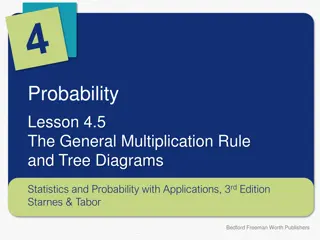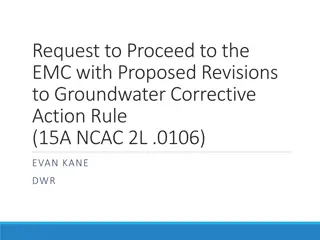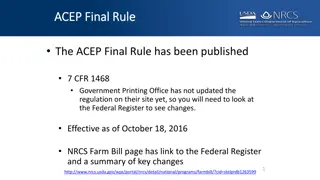NFL's PAT Rule Evolution: Strategic Implications Revealed
NFL's PAT rule has evolved over the years to keep games exciting, with changes in scoring methods and difficulty levels. The strategic implications include maintaining fan interest, adding excitement, and challenging coaches. The rule adjustments have balanced scoring dynamics, creating a more dynamic and engaging experience for fans.
Download Presentation

Please find below an Image/Link to download the presentation.
The content on the website is provided AS IS for your information and personal use only. It may not be sold, licensed, or shared on other websites without obtaining consent from the author. Download presentation by click this link. If you encounter any issues during the download, it is possible that the publisher has removed the file from their server.
E N D
Presentation Transcript
Strategy implications of the NFLs PAT rule Harold Sackrowitz Rutgers University
Background In 1958 colleges instituted a 2-point conversion option after a touchdown. Then in 1994 the NFL decided to do the same. In the NFL, from 1994 through 2014, after a team scored a touchdown the clock was stopped. The ball was placed at the 2 yard line and the team that just scored got to run one play. If the ball was kicked through the uprights (roughly the equivalent of a 20 yard field goal) they got 1 extra point. If they managed to carry or pass the ball into the end zone they got 2 extra points.
Here the idea was keep the outcome of games in doubt and keep fans in their seats or front of their TV for a longer period of time. After all, football is in the entertainment business. The last Super Bowl was a perfect example. The Patriots were behind by 16 points with less than 10 minutes left in the game, but, were able to catch up by converting two 2- point conversion attempts. It turned a dull easy win into one of the most exciting games ever.
Positives The outcome of games would remain in doubt for longer. There would be more controversial decisions and more second guessing opportunities. This would make the game more vibrant and increase fan interest. Negatives (?) It gave coaches another thing to think about and to be judged on.
Let p1 = true prob. of a successful 1-pt conversion attempt. Let p2 = true prob. of a successful 2-pt conversion attempt. Let f1and f2be the corresponding observed success rates. In 1998 when I first became curious the NFL averages were f1= .983 f2= .38
By 2014 the yearly league f1value, with over 1100 attempts per year, had risen to over 99%. The f2rate, which was based only on about 70 two-point attempts per year, was much more variable. It had been fluctuating in the upper 40% to around 50%. The NFL determined that the 1-point attempt had become too automatic and held little to no fan interest. From an entertainment point of view something had to be done.
Beginning with the 2015 season the 1-point attempt was made more difficult. Now, for the 1-point attempt the ball is placed at the 15 yard line so that the kick is equivalent to a 33 yard field goal. For the 2-point attempt the ball was still placed at the 2 yard line.
Leading up to the 2015 season the media did pay some modest amount of attention to the proposed rule. The reaction of the football community was very subdued. The predominant feeling was that place kickers had become so good that it wouldn t make much difference in play calling. What do you think?
Here are the rates for the last two years. 1-point success rate in 2015 = 1177/1250 = .942 1-point success rate in 2016 = 1164/1246 = .934 1-point success rate combined= 2341/2496 = .938 2-point success rate in 2015 = 50/100 = .500 2-point success rate in 2016 = 55/112 = .491 2-point success rate combined= 105/212 = .495
Mathematically, a key issue turns out to be the relationship between the expected value of a 1-point attempt = p1 the expected value of a 2-point attempt = 2p2 and If p1> 2p2then always attempting a 1-point conversion will maximize the expected number of points scored. If p1< 2p2then always attempting a 2-point conversion will maximize the expected number of points scored.
Maximizing the expected number of points scored is not the same as maximizing the probability of winning. Thus some attempt at computing actual probabilities would seem to be appropriate. Historically, before 2015, when discussing PATs people have always tacitly assumed that the true rates satisfied p1> 2p2 even if the observed rates didn t hold in some years.
An optimal game strategy chart should, after scoring each TD, specify the PAT choice that maximizes the probability of winning the game. This is especially intriguing because the solution needs to involve time remaining and also it is a problem that can not be fully resolved empirically.
Getting precise probabilities in actual game situations is not really possible as they depend on too many unknown quantities. Furthermore, there aren t even good ways to estimate most of these quantities. However, exact probabilities can be found for well defined game models that approximate football game conditions. These results can supply coaches with valuable information that will allow them to make more informed PAT decisions.
For the model I chose, time remaining is measured in number of possessions. This is the natural way coaches seem to approach their strategy. For each team, suppose we know the rate at which they score field goals, the rate at which they score touchdowns, p1and p2. Think of these values as initial conditions.
Under such conditions using the method of dynamic programming (or backward deduction) optimal strategies can be found exactly. This process is described in a 2000 paper I wrote for Chance. The method begins at the end of the game (i.e., 0 possessions remaining) when the probabilities and optimal decisions are easily obtained. Then, using induction equations, one moves backward to 1 possession remaining, then 2, etc. What is not standard is having two teams with opposite goals.
To appreciate the usefulness of this approach and the level of impact of the new rule change we will look at the strategy results for 3 sets of initial conditions.
Initial Conditions A: p1= .99 and p2= .42 success rates for one- point and two-point conversion attempts respectively with teams scoring field goals and touchdowns on 13% and 21% of possessions respectively. Initial Conditions B: p1= .99 and p2= .47 success rates for one- point and two-point conversion attempts respectively with teams scoring field goals and touchdowns on 19% and 30% of possessions respectively. Initial Conditions C: p1= .938 and p2= .495 success rates for one- point and two-point conversion attempts respectively with teams scoring field goals and touchdowns on 13% and 21% of possessions respectively.
Stars indicate different for Conditions B total possessions remaining in the game Behind 0 1 2 3 4 5 6 7 8 9 10 11 12 13 14 15 16 17 18 19 20 by 19 2 2 2 2 2 2 2 2 2 2 2 2 2 2 2 10 2 2 2 2 1* 2 1 1* 1 1* 1 1 1 1 1 1 1 1 1 9 2 2 2 2 2 2 2 2 2 2 2 2 1* 1* 1* 1* 1 8 2 2 2 2 2 2 2 2 2 1* 1* 1 1 1 1 1 1 1 1 7 1 1 1 1 1 1 1 1 1 1 1 1 1 1 1 1 1 1 1 6 1 1 1* 1* 1* 1* 1* 1* 1* 1* 1* 1* 1 1* 1 1 1 1 1 5 2 2 2 2 2 2 2 2 2 2 2 2 2 2 2 1* 1 1 1 4 1 1 1 1 1 1 1 1 1 1 1 1 1 1 1 1 1 1 1 3 1 1 1 1 1 1 1 1 1 1 1 1 1 1 1 1 1 1 1 2 2 2 2 2 2 2 2 2 2 2 2 2 2 2 2 2 2 2 1 1 1 1 1 1 1 1 1 1 1 1 1 1 1 1 1 1 1 1 1 1 1 1 1
Stars indicate different for Conditions B total possessions remaining in the game Ahead 0 1 2 3 4 5 6 7 8 9 10 11 12 13 14 15 16 17 18 19 20 by 0 1 1 1 1 1 1 1 1 1 1 1 1 1 1 1 1 1 1 1 1 1 1 2 2 2 2 2 2* 2 1 2 1 1 1 1 1 1 1 1 1 1 1 2 1 2* 2* 2 2 2 2 2 2 2 2 2 1 1 1 1 1 1 1 1 3 1 1 1 1 1 1 1 1 1 1 1 1 1 1 1 1 1 1 1 1 4 2 1 1 1 1 1 1 1 1 1 1 1 1 1 1 1 1 1 1 1 5 2 2 2 2 2 2 2 2 2 2 2 2 2 1* 1* 1* 1* 1 1 1 6 1 1 1 1 1 1 1 1 1 1 1 1 1 1 1 1 1 1 1 1 7 1 1 1 1 1 1 1 1 1 1 1 1 1 1 1 1 1 1 1 1 8 1 1 1 1 1 1 1 1 1 1 1 1 1 1 1 1 1 1 1 1 9 1 1 1 1 1 1 1 1 1 1 1 1 1 1 1 1 1 1 10 1 1 1 1 1 1 1 1 1 1 1 1 1 1 1 1 1 1
Under new rule Under new rule (conditions C). total possessions remaining in the game Ahead 0 1 2 3 4 5 6 7 8 9 10 11 12 13 14 15 16 17 18 19 20 by 0 1 1 1 1 1 1 1 1 1 1 1 1 1 1 1 2 2 2 2 2 2 1 2 2 2 2 2 2 2 2 2 2 2 2 2 2 2 2 2 2 2 2 2 2 2 2 2 2 2 2 2 2 2 2 2 2 2 2 2 2 2 2 2 3 1 1 1 1 1 1 1 1 1 1 1 1 1 1 1 1 2 2 2 2 4 2 2 2 2 2 2 2 2 2 2 2 2 2 2 2 2 2 2 2 2 5 2 2 2 2 2 2 2 2 2 2 2 2 2 2 2 2 2 2 2 2 6 1 1 1 1 1 1 1 1 1 1 1 1 1 1 1 1 1 2 2 2 7 2 2 2 2 2 2 2 2 2 2 2 2 2 2 2 2 2 2 2 2 8 1 1 1 1 1 1 1 1 2 1 2 2 2 2 2 2 2 2 2 2 9 1 1 1 1 1 1 1 1 1 1 1 1 1 1 2 2 2 2 10 2 2 2 2 2 2 2 2 2 2 2 2 2 2 2 2 2 2
Under new rule Under new rule (conditions C). total possessions remaining in the game Behind 0 1 2 3 4 5 6 7 8 9 10 11 12 13 14 15 16 17 18 19 20 by 10 2 2 2 2 2 2 2 2 2 2 2 2 2 2 2 2 2 2 2 9 2 2 2 2 2 2 2 2 2 2 2 2 2 2 2 2 2 2 8 2 2 2 2 2 2 2 2 2 2 2 2 2 2 2 2 2 2 2 7 1 1 1 1 1 1 1 1 1 1 1 1 2 2 2 2 2 2 2 6 1 1 1 1 1 2 2 2 2 2 2 2 2 2 2 2 2 2 2 5 2 2 2 2 2 2 2 2 2 2 2 2 2 2 2 2 2 2 2 4 1 1 1 1 1 1 1 1 1 1 1 2 2 2 2 2 2 2 2 3 1 1 1 1 1 1 1 1 1 2 2 2 2 2 2 2 2 2 2 2 2 2 2 2 2 2 2 2 2 2 2 2 2 2 2 2 2 2 2 2 2 1 2 ? 2 2 2 2 2 2 2 2 2 2 2 2 2 2 2 2 2 2 2
I am convinced that the entry in red will occur during virtually every NFL season regardless of what the PAT rules are. Everyone will have an opinion on what to do and what should have been done. We have just scored a TD, we are behind by 1 point and there is only 1 possession remaining in the game.
Regardless of our PAT choice and its result we will lose if our opponent scores during that last possession. What should we be thinking? If we go for 1 then P(we win) = ( p1 ) P(opponent doesn t score) If we go for 2 then P(we win) = p2P(opponent doesn t score)
What we need to know is ( p1 ) Q0 > p2Q1 (i.e., go for 1) or ( p1 ) Q0 < p2Q1 (i.e., go for 2) where Q0= the probability that our opponent will not score when the score is tied and it is their last possession and Q1= the probability that our opponent will not score when they are behind by 1 and it is their last possession.
Need to compare (note that Q0 Q1) p1 /(2p2) with Q1/Q0. Over the last two years we observed f1 /(2f2) = .938/(2 x .495) = .947
Here are three examples of this situation that occurred last season. They are all slightly different and it is not clear which decisions were correct. What would have been needed were good estimates of p1 , p2, Q0and Q1.
Oakland Raiders score a TD and are behind to the New Orleans Saints 34 33 with 47 seconds remaining in the game. They go for 2 and win 35 34. Kansas City Chiefs score a TD and are behind to the San Diego Chargers 27 26 with 67 seconds remaining in the game. They go for 1 and win 33 27 in overtime. Carolina Panthers score a TD and are behind to the Tampa Buccaneers 17 16 with 17 seconds remaining in the game. They go for 2 and lose 17 - 16.
The results of the first two weeks of this years games changes leaves f1intact but lowers f2to .484. This changes some of the entries in the table for Initial Conditions C. These are indicated in red in the following two tables.
Under new rule Under new rule (conditions C). total possessions remaining in the game Ahead 0 1 2 3 4 5 6 7 8 9 10 11 12 13 14 15 16 17 18 19 20 by 0 1 1 1 1 1 1 1 1 1 1 1 1 1 1 1 1 1 2 2 2 2 1 2 2 2 2 2 2 2 2 2 2 2 2 2 2 2 2 2 2 2 2 2 2 2 2 2 2 2 2 2 2 2 2 2 2 2 2 2 2 2 2 2 3 1 1 1 1 1 1 1 1 1 1 1 1 1 1 1 1 1 1 1 2 4 2 2 2 2 2 2 2 2 2 2 2 2 2 2 2 2 2 2 2 2 5 2 2 2 2 2 2 2 2 2 2 2 2 2 2 2 2 2 2 2 2 6 1 1 1 1 1 1 1 1 1 1 1 1 1 1 1 1 1 1 1 1 7 2 2 2 2 2 2 2 2 2 2 2 2 2 2 2 2 2 2 2 2 8 1 1 1 1 1 1 1 1 2 1 2 1 9 1 1 1 1 1 1 1 1 1 1 1 1 1 1 1 1 1 1 10 2 2 2 2 2 2 2 2 2 2 2 2 2 2 2 2 2 2 2 2 2 2 2 2 2 2
Under new rule Under new rule (conditions C). total possessions remaining in the game Behind 0 1 2 3 4 5 6 7 8 9 10 11 12 13 14 15 16 17 18 19 20 by 10 2 2 2 2 2 2 2 2 2 2 2 2 2 2 2 2 2 2 2 9 2 2 2 2 2 2 2 2 2 2 2 2 2 2 2 2 2 2 8 2 2 2 2 2 2 2 2 2 2 2 2 2 2 2 2 2 2 2 7 1 1 1 1 1 1 1 1 1 1 1 1 1 1 1 2 2 2 2 6 1 1 1 1 1 2 2 2 2 2 2 2 2 2 2 2 2 2 2 5 2 2 2 2 2 2 2 2 2 2 2 2 2 2 2 2 2 2 2 4 1 1 1 1 1 1 1 1 1 1 1 1 1 1 2 2 2 2 2 3 1 1 1 1 1 1 1 1 1 2 1 2 2 2 2 2 2 2 2 2 2 2 2 2 2 2 2 2 2 2 2 2 2 1 2 ? 2 2 2 2 2 2 2 2 2 2 2 2 2 2 2 2 2 2 2 2 2 2 2 2 2 2 2
A last look at the 2017 Super Bowl A last look at the 2017 Super Bowl New England 0 3 6 19 6 - 34 Atlanta 0 21 7 0 0 - 28 N.E. misses 1-point try at 2:06 in 3rdwhen behind 28 9. N.E. makes FG at 9:44 in 4thto make score 28 12. N.E. scores TD plus 2-point conversion with 5:56 remaining. N.E. regains possession on their own 9 yard line with 3:30 remaining. N.E. ties game with TD plus 2-point conversion with 0:57 remaining.
Consider the decision the Patriots made to go for one extra point with 2:06 remaining in the 3rd quarter. They were behind by 19 points and, certainly, there were fewer than 10 possessions remaining. Even, under Initial Conditions A, when p1= .99 and p2= .42 the table indicates that going for two was the percentage play.
Stars indicate different for Conditions B total possessions remaining in the game Behind 0 1 2 3 4 5 6 7 8 9 10 11 12 13 14 15 16 17 18 19 20 by 19 2 2 2 2 2 2 2 2 2 2 2 2 2 2 2 10 2 2 2 2 1* 2 1 1* 1 1* 1 1 1 1 1 1 1 1 1 9 2 2 2 2 2 2 2 2 2 2 2 2 1* 1* 1* 1* 1 8 2 2 2 2 2 2 2 2 2 1* 1* 1 1 1 1 1 1 1 1 7 1 1 1 1 1 1 1 1 1 1 1 1 1 1 1 1 1 1 1 6 1 1 1* 1* 1* 1* 1* 1* 1* 1* 1* 1* 1 1* 1 1 1 1 1 5 2 2 2 2 2 2 2 2 2 2 2 2 2 2 2 1* 1 1 1 4 1 1 1 1 1 1 1 1 1 1 1 1 1 1 1 1 1 1 1 3 1 1 1 1 1 1 1 1 1 1 1 1 1 1 1 1 1 1 1 2 2 2 2 2 2 2 2 2 2 2 2 2 2 2 2 2 2 2 1 1 1 1 1 1 1 1 1 1 1 1 1 1 1 1 1 1 1 1 1 1 1 1 1
